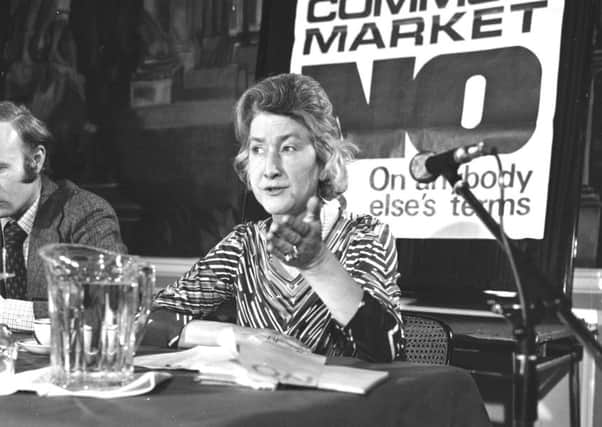Martin Hannan: Changed days in Europe row


It was an “in or out” vote, the UK having joined the European Economic Community, as it was then called, on January 1, 1973, along with Denmark and the Republic of Ireland.
We Brits were not individually asked for our views before Ted Heath’s Conservative government took us into the EEC, or Common Market as it was more commonly called.
Advertisement
Hide AdAdvertisement
Hide AdWhen Harold Wilson and Labour took power in February 1974, they did so on a platform of renegotiating the terms of Britain’s membership and putting the new package to the people, a policy that angered many pro-European Labour MPs. Even a vote to seek a “consultative referendum” in 1972 had led to the resignation of the party’s deputy leader, Roy Jenkins. Funny how many of the “people’s party” didn’t actually trust the
people . . .
Wilson caught the mood of the people and in the second election of 1974, Labour’s policy was even firmer – there would be an “in or out” vote as soon as possible, after the Wilson government renegotiated the terms for Britain to stay in the EEC.
It was close run thing over those negotiations. It was only in Dublin on March 11 that Wilson won concessions – the UK did not have to put VAT on food and would get more money back from the Community than previously, with guarantees of a better trade deal for the Commonwealth countries.
It was enough for the government to go to the people supporting Yes, though officially the Labour Party took no side and even Cabinet ministers such as Tony Benn were allowed to campaign for a No vote.
Advertisement
Hide AdAdvertisement
Hide AdThe vast majority of the press actively campaigned for a Yes vote, with the right-wing tabloids targeting the Labour left for their ire – Benn was memorably dubbed the “Minister of Fear” for his stance.
The 1975 vote was decisive. The question asked was: “Do you think that the United Kingdom should remain part of the European Community (the Common Market)?” – to be answered Yes or No.
Some 17.3 million people voted Yes, with 8.5 million voting No, giving a figure of 62.7 per cent for staying in the EEC against 37.8 wanting out. The figures for Scotland were 58.4 per cent for Yes to 41.6 per cent No. Only two areas in the whole of the UK voted No – Shetland and the Western Isles.
I remember well how the left wing of the Labour Party and the Eurosceptic wing of the Conservatives made strange bedfellows in the No campaign – joined in it by my party, the SNP.
Advertisement
Hide AdAdvertisement
Hide AdNow as we face the prospect of a second referendum, the situation has radically altered. It’s a Conservative government which is renegotiating the terms of Britain’s membership of a drastically altered European Union, though one thing hasn’t changed – Labour are still in a muddle over their stance.
In contrast to 1975, the SNP leadership supports staying in Europe calculating – correctly, I think – that Scotland’s economy is now so dependent on the European Union that we need to stay in.
Me? I honestly do not know how I’m going to vote. Do you? Next week I will explain my concerns.
Storm highlights city safety flaws
If Storm Gertrude did us any favours last week – and it mostly didn’t – it showed that Edinburgh still has a problem with insecure and unsafe roofs and walls.
Advertisement
Hide AdAdvertisement
Hide AdThe falling masonry which hit the number 31 bus and fortunately only slightly injured a passenger was a dreadful reminder of how an Australian waitress was killed by debris falling off a four-storey building in the West End in June 2000.
That happened in summer, but I recall speaking to a senior police officer near the scene who said: “One of these days we’ll get a big storm and this will be happening all over the place.”
Too true. After Gertrude, there must be inspections to ensure such a tragedy cannot happen again.
Graeme’s tales are worth a read
Graeme E Pearson is a well-known figure on the pub music scene in Edinburgh, probably best known for founding his musical walking tour of the city.
Advertisement
Hide AdAdvertisement
Hide AdTo mark the 25th anniversary of starting his singing career, he has published a book called Edinburgh My Story, and he does not spare himself in recounting his occasionally haphazard adventures in the Capital and elsewhere.
It’s very funny in parts
and also very moving in others – the tale of his battle with cancer is quite inspirational.
Well worth a read and you can find out more about the book at www.graemeepearson.co.uk.
Hibees’ cup can runneth over
Congratulations to Hibs on making the Scottish League Cup final in which they will play Ross County, conquerors of Celtic.
Advertisement
Hide AdAdvertisement
Hide AdNormally a second-tier club facing a Premiership side would be no contest, but the much-criticised Easter Road board has kept Hibs going as a top-flight club in all but name, and I really fancy them to win at Hampden on March 13.
Nowhere fast
Much has been written about this Edinburgh to London hyperloop which would see people transported between the two capitals in 30 minutes. It’s well named – hype is the word.